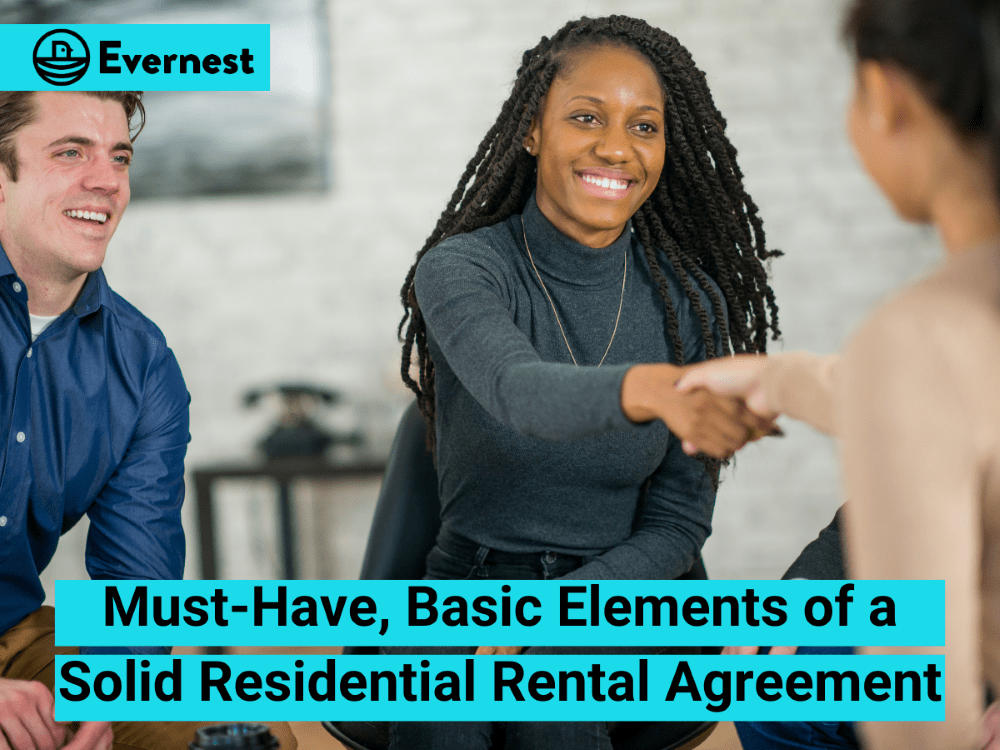A residential rental agreement, or just rental agreement, is an essential legal document that outlines the rights and obligations of both landlords and residents during a resident’s stay in a rental property.
If you’re on the journey of renting your property and want to better understand what must be included in a solid residential rental agreement to ensure everyone is protected, you’ve come to the right place.
Table of Contents
What is in a residential rental agreement?
A lease agreement covers the terms and conditions of the tenancy, including details about the property, rent, security deposit, and responsibilities of both resident and landlord throughout the length of the lease term.
When it comes to the property itself, a lease agreement provides a detailed description of the property being rented. This includes not only the physical address but also specific details about the property’s features, such as the number of bedrooms and bathrooms, the square footage, and any additional amenities like a swimming pool or a garage. It could also outline what may be onsite but not included in the rental agreement such as a detached garage or storage shed.
In addition to the property details, a lease agreement also outlines the financial aspects of the tenancy including the monthly rent amount, the due date, late fees or penalties for missed or delayed payments, and the required security deposit.
A solid rental agreement should also outline the responsibilities of both the landlord and the resident during the tenancy which would include information about who is responsible for maintenance and repairs, as well as any restrictions on alterations or modifications to the property. It may also specify rules regarding noise levels, pet policies, HOA policies, and other important considerations residents need to be aware of.
Overall, a lease agreement is essential to building a reliable foundation for the rental arrangement. By including detailed information about the property, rent, security deposit, and responsibilities of both parties, the agreement ensures that everyone involved is on the same page and has a resource to refer back to should any issues or disputes arise.
Now that you know the basics, let’s walk through each element of a solid rental agreement in more detail.
Who?
It may seem obvious, but it’s important to understand who is included in a rental agreement. There are two primary parties involved: the landlord (also known as the lessor) and the resident (also known as the lessee). The landlord owns the property and grants the resident the right to occupy it for a specified period.
Landlords are responsible for maintaining the property, ensuring it meets all safety and health standards, and addressing any repairs or maintenance issues that may come up during the tenancy. Landlords may also have additional responsibilities, such as providing certain amenities or services, depending on the terms of the rental agreement.
Residents have the right to occupy and use the property for the length of the agreed-upon period so are responsible for paying rent on time, adhering to the terms of the lease, and taking care of the property. They must also follow any rules set by the landlord or the property manager, such as noise restrictions or pet policies.
It’s common for landlords to enlist the help of a property manager who would create and facilitate the rental agreement process based on the property details and the landlord’s desires. Property management services often include finding great residents, negotiating rental agreement terms, and handling disputes on the landlord’s behalf which can be invaluable for everyone involved.
All parties have a responsibility to educate themselves about the terms of their residential rental agreement and landlords should take extra care to familiarize themselves with local laws governing rental properties to ensure they comply.
Occupants
In a similar vein, a lease agreement should stipulate the number of individuals allowed to occupy the property. This ensures that the property is not being sublet without the landlord’s knowledge or consent.
Terms

Any rental agreement needs to clearly state the length of the tenancy, whether it’s for a fixed term or a month-to-month basis as well as the start and end dates of the agreement.
Fixed-term rental agreements are a popular option among landlords because they offer a certain amount of security and reliability. These agreements last for a specific period, such as twelve months, and the rental agreement is in place until the end of that period.
On the other hand, month-to-month rental agreements offer more flexibility for residents and landlords as they automatically renew at the end of each calendar month unless either party gives notice to terminate the agreement. These kinds of rental agreements are usually preferred by residents who need the flexibility to relocate on short notice due to work or personal life circumstances but may not be as preferable to landlords as they are on the hook to find a new resident at any time.
Renewal Terms
If the tenancy is for a fixed term, it’s important to include conditions for the renewal of the lease. This could include requirements such as giving notice within a certain timeframe or meeting specific criteria set by the landlord.
Renewal options allow residents to extend their lease if they want to continue living in the rental property, while also allowing landlords to decide whether they want that resident to stay for a longer period.
Rent
The bit of information that all parties are most interested in is the total monthly rent amount. This information should be clearly stated in any residential rental agreement along with the monthly due date and the acceptable payment methods (i.e. check, via an online portal, cash, etc.) It’s also important to outline the penalties for late payments and the consequences of non-payment should the resident delay or fail to pay rent entirely.
Remember, a professional property management company can help you collect rent in-full and on-time!
Security deposit
A security deposit is a sum of money paid by a resident to a landlord as a form of protection against damages or unpaid rent. Consider this deposit as a safety net that ensures any unfortunate damage beyond normal wear and tear or missed payment doesn’t amount to a financial burden for a landlord. The total deposit amount, the conditions under which it will be refunded, and any deductions that may be made from it must all be included within the agreement.
It should be made clear that this deposit is not the last month’s rent and that it will be held until a walkthrough of the property can be done following the resident’s move out. Once damages are assessed, security deposits must be returned to a resident promptly — the exact turnaround time will depend on local rules and regulations.
Late Fees
In some cases, residents may fail to pay rent on time. To ensure a landlord’s interests are protected in these cases, a rental agreement should specify any late fees or penalties that will be applied if the resident fails to pay by the due date.
Utilities and Services
The rental agreement should clearly state which utilities and services are included in the rent and which are the responsibility of the resident to cover separately. This can include electricity, water, internet, trash, and any maintenance fees for shared spaces. Be sure to indicate whether residents need to set up accounts to ensure these services aren’t forgotten or mishandled.
Maintenance and Repairs
There will inevitably come a time when maintenance is required on a rental property. Residential spaces require a lot of upkeep and this doesn’t change when being rented out. For this reason, it’s crucial to outline the responsibilities of both the landlord and resident when maintenance is needed. The lease agreement should lay out who is responsible for routine maintenance, such as lawn care, as well as one-time repairs.
If working with a property manager, there is often a portal or specific contact for maintenance requests which streamlines and simplifies the repair process and creates a seamless experience for everyone. This is one of the most important processes to stay on top of as a landlord. After all, there’s no quicker way to lose your resident than to ignore or mishandle their maintenance requests!
Resident Obligations
There should be space in a lease agreement to clearly state the obligations of residents, including maintaining cleanliness, complying with noise regulations, and respecting the property and its neighbors. This helps to establish a peaceful living environment and a general sense of respect for a rental property.
Insurance
While the landlord typically holds insurance for the property, it is important to specify whether the resident is required to obtain renter’s insurance as well. Renter’s insurance can protect the resident’s belongings and provide additional liability coverage so we always recommend requiring that a resident obtain a policy and provide proof of coverage before moving in.
Right to Access the Property
Residents cannot deny a landlord or property manager access to the property to make repairs or inspect. The lease agreement should therefore establish the landlord or property manager’s right to access the property and set clear guidelines and notice periods to respect the resident’s privacy and provide ample time for scheduling.
Rate Adjustments
If a long-term lease agreement is in effect, there may come a time when the rent needs to be adjusted due to changes in market conditions or other factors. For this reason, the agreement must include details about the process and notice period for rent increases so the resident is aware of the possibility and the landlord can legally put these changes into effect when the time comes.
Pets
People love their pets! So, pets are common for residents to bring along into a new rental agreement. It’s important to specify any pet-related rules, such as size restrictions, breed restrictions, and additional pet deposits or fees so residents and their furry family members feel safe and the property is respected.
We include rules against certain types of pets allowed on properties we manage. In instances where we do allow a resident’s pet, we require a fee of $300 per animal and enforce a fine of $500 for unauthorized pets being on the property.
Final Thoughts: Building a Solid Residential Rental Agreement
The answer to “How do I safely rent my home?” is easily a solid residential rental agreement. The guidelines detailed above cover each of the most essential elements to consider when crafting your lease agreement and embarking on the journey of renting your property.
If you want the support of an expert property management team on your side to implement a proven lease agreement and keep you covered, consider Evernest! We have many years and countless clients under our belt so you can be sure you’re in experienced hands. Head to our website to find the Evernest team in your area and get started today!


